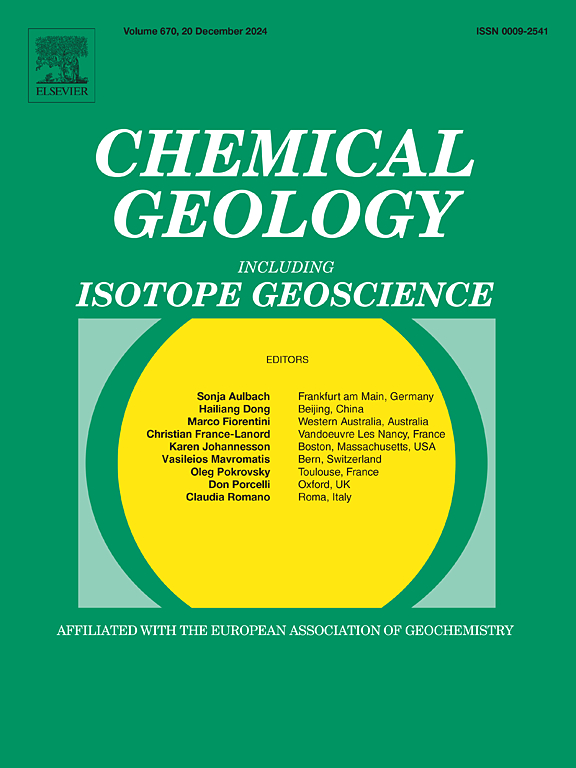中印度洋洋脊玄武岩的Ca-Sr-Nd同位素特征及其对印度洋地幔域再循环物质的意义
IF 3.6
2区 地球科学
Q1 GEOCHEMISTRY & GEOPHYSICS
引用次数: 0
摘要
来自印度洋的洋中脊玄武岩(MORBs)已被证明比来自太平洋和大西洋的MORBs具有更丰富的放射性成因同位素组成。然而,这种异常的起源仍在争论中。为了更好地约束在印度morb中观测到的同位素异常的成因,我们对19 - 20°S之间的中印度脊(CIR)和邻近的加西陶脊(Gasitao Ridge)的一套morb进行了系统的Ca-Sr-Nd同位素研究。这些morb的δ44/40Ca值在0.70 ~ 0.89‰之间,大部分与太平洋和大西洋morb的δ44/40Ca值相近。然而,研究区北部部分样品的δ44/40Ca值略低于报道的太平洋和大西洋morb的平均值。值得注意的是,这些δ44/40Ca值与SrNd同位素比值相关,这些δ44/40Ca值与SrNd同位素比值相关,表明这些印度MORB的来源中存在富集成分,从枯竭的MORB地幔延伸到δ44/40Ca较低、SrNd同位素组成较富集的地幔。最近的研究表明,下大陆地壳的δ44/40Ca值与估计的块状硅酸盐土相似,这表明一些印度morb的低δ44/40Ca特征不太可能是由下大陆地壳剥离产生的。地幔源岩δ44/40Ca信号较低的原因是海壳沉积物中残留和再循环富碳酸盐岩中的石榴石。然而,微量元素比例和我们的模型计算表明,这两个因素很难引起这些印度morb中Ca-Sr-Nd的相关趋势。相反,最近报道的经历硅酸盐和/或碳酸盐岩交代的次大陆岩石圈地幔包体,也显示出低δ44/40Ca和丰富的SrNd同位素组成,与所研究的印度morb的相关Ca-Sr-Nd趋势相对应。此外,在西南印度洋脊的深海橄榄岩中还发现了古交代的次大陆岩石圈地幔物质。因此,剥离的次大陆岩石圈地幔可能是导致印度morb中Ca-Sr-Nd同位素异常的最可能原因。我们的研究表明,Ca-Sr-Nd组合同位素可以作为地幔非均质成因的潜在示踪剂。本文章由计算机程序翻译,如有差异,请以英文原文为准。
Ca-Sr-Nd isotopic signatures of mid-ocean ridge basalts from the Central Indian Ridge and implications for recycled materials in the Indian Ocean mantle domain
Mid-ocean ridge basalts (MORBs) from the Indian Ocean have been demonstrated to have more enriched radiogenic isotopic compositions than MORBs from the Pacific and Atlantic Oceans. However, the origin of such anomaly is still under debate. To better constrain the genesis of the isotopic anomaly observed in Indian MORBs, we present a systematic Ca-Sr-Nd isotopic study of a suite of MORBs from the Central Indian Ridge (CIR) between 19 and 20°S and the adjacent Gasitao Ridge. The δ44/40Ca values of these MORBs vary from 0.70 to 0.89 ‰, most of which are similar to those of reported Pacific and Atlantic MORBs. However, some samples from the northern part of the studied CIR region showed slightly lower δ44/40Ca values than the average of the reported Pacific and Atlantic MORBs. Notably, these δ44/40Ca values are correlated with Sr![]() Nd isotopic ratios, which extend from the depleted MORB mantle to a component with lower δ44/40Ca and more enriched Sr
Nd isotopic ratios, which extend from the depleted MORB mantle to a component with lower δ44/40Ca and more enriched Sr![]() Nd isotopic compositions, suggesting the presence of an enriched component in the source of these Indian MORBs. Recent studies have proposed that lower continental crust has similar δ44/40Ca values to the estimated Bulk Silicate Earth, indicating that the low δ44/40Ca signatures of some Indian MORBs are unlikely to be produced by delaminated lower continental crust. Garnet in the residue and recycled carbonate-rich marine sediments with oceanic crust can cause lower δ44/40Ca signatures in mantle-derived rocks. However, trace element ratios and our model calculations suggest that these two factors can hardly induce the correlated Ca-Sr-Nd trends in these Indian MORBs. Instead, recently reported subcontinental lithospheric mantle xenoliths that experienced silicate and/or carbonatite metasomatism, which also show low δ44/40Ca and enriched Sr
Nd isotopic compositions, suggesting the presence of an enriched component in the source of these Indian MORBs. Recent studies have proposed that lower continental crust has similar δ44/40Ca values to the estimated Bulk Silicate Earth, indicating that the low δ44/40Ca signatures of some Indian MORBs are unlikely to be produced by delaminated lower continental crust. Garnet in the residue and recycled carbonate-rich marine sediments with oceanic crust can cause lower δ44/40Ca signatures in mantle-derived rocks. However, trace element ratios and our model calculations suggest that these two factors can hardly induce the correlated Ca-Sr-Nd trends in these Indian MORBs. Instead, recently reported subcontinental lithospheric mantle xenoliths that experienced silicate and/or carbonatite metasomatism, which also show low δ44/40Ca and enriched Sr![]() Nd isotopic compositions, correspond with the correlated Ca-Sr-Nd trends in the studied Indian MORBs. Moreover, ancient metasomatized subcontinental lithospheric mantle materials have been observed in abyssal peridotites from the Southwest Indian Ridge. Therefore, delaminated subcontinental lithospheric mantle maybe the most likely cause of the Ca-Sr-Nd isotopic anomaly in Indian MORBs. Our study suggests that combined Ca-Sr-Nd isotopes can be treated as potential tracers to the genesis of mantle heterogeneity.
Nd isotopic compositions, correspond with the correlated Ca-Sr-Nd trends in the studied Indian MORBs. Moreover, ancient metasomatized subcontinental lithospheric mantle materials have been observed in abyssal peridotites from the Southwest Indian Ridge. Therefore, delaminated subcontinental lithospheric mantle maybe the most likely cause of the Ca-Sr-Nd isotopic anomaly in Indian MORBs. Our study suggests that combined Ca-Sr-Nd isotopes can be treated as potential tracers to the genesis of mantle heterogeneity.
求助全文
通过发布文献求助,成功后即可免费获取论文全文。
去求助
来源期刊

Chemical Geology
地学-地球化学与地球物理
CiteScore
7.20
自引率
10.30%
发文量
374
审稿时长
3.6 months
期刊介绍:
Chemical Geology is an international journal that publishes original research papers on isotopic and elemental geochemistry, geochronology and cosmochemistry.
The Journal focuses on chemical processes in igneous, metamorphic, and sedimentary petrology, low- and high-temperature aqueous solutions, biogeochemistry, the environment and cosmochemistry.
Papers that are field, experimentally, or computationally based are appropriate if they are of broad international interest. The Journal generally does not publish papers that are primarily of regional or local interest, or which are primarily focused on remediation and applied geochemistry.
The Journal also welcomes innovative papers dealing with significant analytical advances that are of wide interest in the community and extend significantly beyond the scope of what would be included in the methods section of a standard research paper.
 求助内容:
求助内容: 应助结果提醒方式:
应助结果提醒方式:


